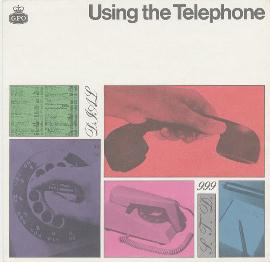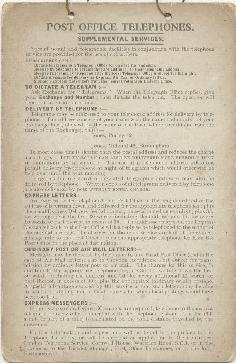 |
Telephone Area Offices played a key role in educating the customers as to the correct use of the telephone service and how to get the most from the equipment and facilities that were supplied. |
Telephone instruments were a new and novel phenomenon in many households and it was prudent for the well-ordered GPO to supply instructions on how to operate them. Even well into the 1980s, not every home had a their own telephone, and so there were many different versions of the user guides printed over the years.
Using the Telephone
Making a call
Make sure that you really know the number you want-
don't guess at it. If you are in any doubt check it in
the telephone directory.
Most calls can be dialled, so refer to your dialling
instructions to see if you can dial the call yourself.
Dial the number carefully, taking the dial right round
to the finger-stop and letting it return freely for each
digit. If you make a mistake while dialling, replace the
receiver for a moment or two, and then start again.
Don't be impatient!
After you have dialled, give the equipment at the
exchange time to connect the call; normally it takes no
more than a moment or so, but on some calls it may
take up to half-a-minute.
When your call is answered say who you want to talk
to and then say who you are.
If you know the number you are calling has a
switchboard, give the extension number you require:
If you don't know it, enquire and make a note of it
for future use.
For calls which you cannot dial yourself-ask the
operator for the number you require. Don't ask for
"Smiths at Sheffield" when making a call via your
private switchboard operator-quote the full number
required. Where possible, stay on the line while she
dials the call for you.
|
What the tones tell you
Dialling tone
means the exchange equipment is ready for you
to start dialling.
Don't dial before you hear this tone or you may get
a wrong number.
Ringing tone
means that the called number is being rung. Allow a
reasonable time for an answer; if there is no reply
replace the receiver and try again later.
Engaged tone
usually means the number you are calling is in use,
but it can also mean that the exchange equipment is busy.
Replace the receiver and try again in about five minutes.
Number unobtainable tone
means that the number you have obtained is either out
of service or spare. If you hear this tone replace your
receiver, check that you are dialling the correct dialling
code and number and then call again.
If you again hear the tone, call the Post Office operator
and explain what has happened.
Pay tone
means that you are being called from a "pay-on-answer"
coin box. The caller must insert money in order to stop
pay tone and speak to you. Give the caller time to put
his money in the box. You yourself will also hear this
tone if you make a call from a "pay-on-answer" coin
box; it means that you call has been answered and
you must put money in the box to speak to the called
person.
If you do not know the sound of these tones the exchange
operator will be pleased to demonstrate them to you.
|
Answering the telephone
Always answer your telephone promptly when it rings,
and announce your identity.
Answer an unattended telephone if you think that it
would be helpful to take a message: Arrange for your
calls to be answered in your absence.
On calls which have come via your private exchange
switchboard answer with your name, department, etc.-
whichever would be most helpful to your callers.
If you answer someone else's telephone say whose it is
or give the number. Have a pencil and paper at hand so
that you can write down a message; and pick up the
receiver with your left hand so that your right hand is
free for writing (or vice versa if you are left-handed).
If you take a message, repeat it back to make sure that
you have taken it down correctly.
And don't forget the caller's name and telephone
number.
See that the message is given to the person for whom it
is intended.
You may have to leave the telephone to make an
enquiry and collect information. If so, tell your caller
how long you expect to be and ask if he would prefer
you to call him back.
|
Don't forget It is better not to shout on the telephone; talk quietly but distinctly into the mouthpiece. Try changing the pitch of your voice and speak more slowly if you have difficulty in being heard. Numbers can be confused when passed over the telephone. -say "fife", so that 5 is not confused with 9 -say "oh", not "nought" which can be confused with 8. Replace the receiver carefully but firmly after each call: you can't receive calls if the receiver is not properly on the rest. If you are cut off on an incoming call, replace your receiver and wait for the other person to call you. Emergency calls From most telephones, if you want the police, fire or ambulance services in an emergency, dial 999. You may also dial 999 for the coastguard. If you want to make an ordinary call to one of these services call the number shown in the telephone directory. Be sure that you know how to make an emergency call from the telephone you use: if it is an extension telephone dialling 999 is not necessarily the correct thing to do. |
Do you know? The telephone directory lists, in alphabetical order, all the telephone subscribers in a locality. There are about sixty telephone directories covering the whole country; in London there are so many subscribers that the directory is in several volumes. You will not always find entries where you might expect them; local authority services-for example, libraries and schools-may be listed under the name of the local or county authority; hotels under the name of the manager and so on. New volumes of telephone directories contain advice on finding numbers. The classified directory lists all business subscribers under their respective trade or profession, for example, Builders, Builders' Merchants, Building Societies. A classified directory is usually printed separately and has a yellow cover, but in new directories it is printed on coloured paper and bound with the alphabetical directory. A dialling instruction booklet is given to each telephone subscriber who has trunk dialling facilities. It lists the exchanges that can be dialled, together with the dialling codes and charges. It also gives you advice |
on the use of the trunk dialling system, including information on how to call all-figure numbers. If Subscriber Trunk Dialling is not available from a telephone, there will usually be a Dialling Code Card listing the codes for nearby exchanges that can be dialled. Personal calls are all connected by the Post Office operator who will ask for the name of the person you are calling as well as the telephone number. The call will not be charged for until the person you want is available, but a fee is payable whether or not the call is ultimately successful. If STD is available from the telephone you are using you can obtain the same facility for yourself by ringing the number and, if necessary, making an appointment to ring again when the person you want is available. Transferred charge calls - The person you are calling may be prepared to pay for the call. If you want the charge for a call transferred, you should start by telling the operator when you book the call; she will want to know your name so that she can enquire if the called person is prepared to pay for the call. |
| PH1542 (4/68) Design Peter Gauld FSIA. Printed by The Artisan Press Ltd, Anstey, Leicester. | |
How to Use the Telephone TE131 (1/32)
A 1932 version of the card.
 |
 |
Post Office G R Telephones |
| TE131_32.docx (MS Word) |
Page last updated 2 June 2021.
All logos and trade marks are the property of their respective owners and are used on the Light Straw site(s) for review only. Students and researchers are recommended to make their own independent enquiries as to the accuracy of the information contained therein.